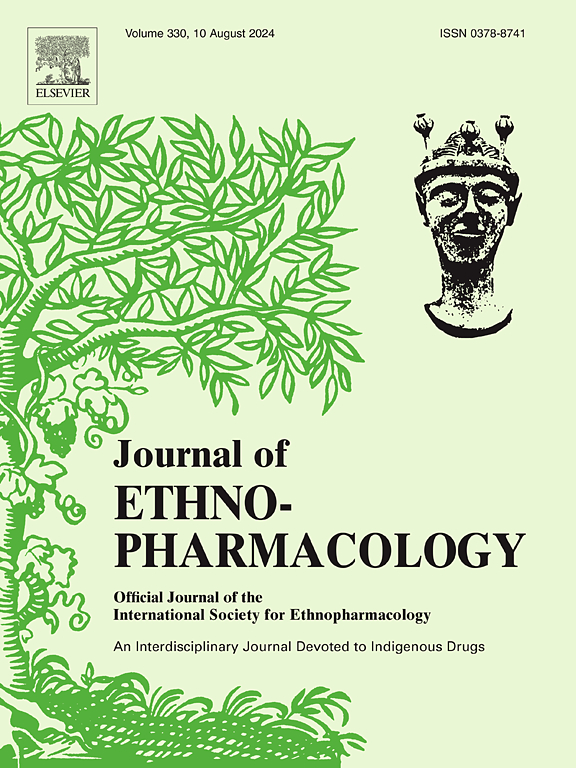Establishing identifiable characteristic fingerprints of mulberry leaves: Integrating chemical composition and bioactivity through machine learning
IF 4.8
2区 医学
Q1 CHEMISTRY, MEDICINAL
引用次数: 0
Abstract
Ethnopharmacological relevance
Mulberry leaves (Morus alba L.) are used in traditional Chinese medicine to clear the lungs and dispel wind-heat. Despite their common use, chemical reference substance rely solely on rutin, which may not reflect their full pharmacological potential.
Aim of the study
To develop a multicomponent quality evaluation strategy for mulberry leaves by integrating HPLC fingerprinting, chemometrics, and biological validation.
Materials and methods
Twenty-seven mulberry leaf samples were analyzed using HPLC. PCA, PLS-DA, and Pearson correlation were applied to identify quality markers. An artificial neural network (ANN) model was constructed based on 17 characteristic peaks. Anti-fibrotic effects were evaluated in bleomycin-induced pulmonary fibrosis mice.
Results
Based on the distribution of chemical reference substances contents in the 27 samples, the mulberry leaves could be categorized into high- and low-content groups, with 0.1 % rutin serving as the classification threshold. An ANN analysis of the HPLC fingerprint was then employed to establish a recognition model based on the full fingerprint, achieving a classification accuracy of 100 %. Rutin correlated with MMP-13 inhibition, and cryptochlorogenic acid with both MMP-13 and PAI-1 inhibition. In vivo studies demonstrated that qualified extracts of mulberry leaves reduced the progression of bleomycin-induced pulmonary fibrosis.
Conclusions
This study establishes a comprehensive and bioactivity-linked quality evaluation framework for mulberry leaves, aligning traditional knowledge with modern scientific assessment.

桑叶可识别特征指纹的建立:通过机器学习整合化学成分和生物活性
与民族药理学相关的桑叶(Morus alba L.)在中药中用于清肺和祛风热。尽管它们被广泛使用,但化学对照物仅依赖于芦丁,这可能无法反映它们的全部药理潜力。目的采用HPLC指纹图谱、化学计量学和生物学验证相结合的方法,建立桑叶多成分质量评价策略。材料与方法采用高效液相色谱法对27份桑叶样品进行分析。应用PCA、PLS-DA和Pearson相关来确定质量标记。基于17个特征峰构建了人工神经网络模型。观察博来霉素致肺纤维化小鼠的抗纤维化作用。结果根据27份样品中化学标准物质的含量分布,可将桑叶分为高、低两类,以0.1%的芦丁为分类阈值。通过对HPLC指纹进行神经网络分析,建立基于全指纹的识别模型,分类准确率达到100%。芦丁与MMP-13抑制相关,隐绿原酸与MMP-13和PAI-1抑制相关。体内研究表明,合格的桑叶提取物可减少博莱霉素诱导的肺纤维化的进展。结论建立了桑叶质量综合评价体系,将传统知识与现代科学评价相结合。
本文章由计算机程序翻译,如有差异,请以英文原文为准。
求助全文
约1分钟内获得全文
求助全文
来源期刊

Journal of ethnopharmacology
医学-全科医学与补充医学
CiteScore
10.30
自引率
5.60%
发文量
967
审稿时长
77 days
期刊介绍:
The Journal of Ethnopharmacology is dedicated to the exchange of information and understandings about people''s use of plants, fungi, animals, microorganisms and minerals and their biological and pharmacological effects based on the principles established through international conventions. Early people confronted with illness and disease, discovered a wealth of useful therapeutic agents in the plant and animal kingdoms. The empirical knowledge of these medicinal substances and their toxic potential was passed on by oral tradition and sometimes recorded in herbals and other texts on materia medica. Many valuable drugs of today (e.g., atropine, ephedrine, tubocurarine, digoxin, reserpine) came into use through the study of indigenous remedies. Chemists continue to use plant-derived drugs (e.g., morphine, taxol, physostigmine, quinidine, emetine) as prototypes in their attempts to develop more effective and less toxic medicinals.
 求助内容:
求助内容: 应助结果提醒方式:
应助结果提醒方式:


